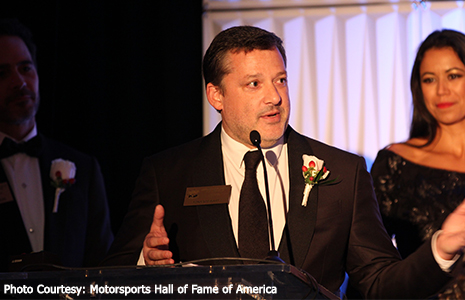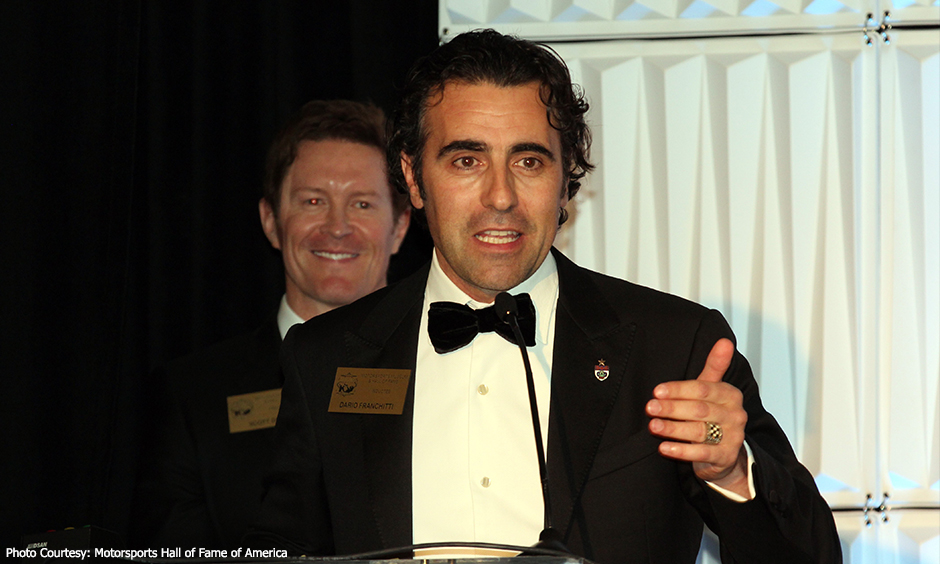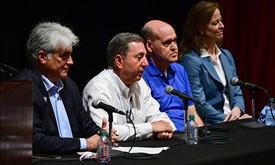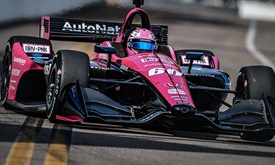Franchitti, Stewart awed by Motorsports Hall of Fame of America inductions
MAR 15, 2019
DAYTONA BEACH, Florida – Dario Franchitti said it didn’t hit him until he arrived. Tony Stewart was in awe of those around him. Such was the feeling when the two racing greats whose careers with deep Indy car ties were inducted into the Motorsports Hall of Fame of America on Tuesday night.
And they weren’t the only inductees whose lives and work are synonymous with open-wheel racing. Augie Duesenberg was an engine and car builder whose efforts launched Indianapolis 500 winners and the careers of countless drivers in the 1920s and ‘30s. While inducted in the Sports Car category, Phil Remington’s design work with Dan Gurney at All American Racers helped produce Indy 500-winning Eagle chassis in the 1970s. And Linda Vaughn was a marketing pioneer for decades at the Indianapolis Motor Speedway, becoming the “first lady of motorsports” as Miss Hurst Shifter and in other promotional roles.
Along with drag racing great Don Schumacher and motorcycle legend Kevin Schwantz, they form the hall’s Class of 2019 and were officially inducted during two days of events.
Franchitti’s career certainly made him worthy of induction. The Scotsman won 31 races, four NTT IndyCar Series championships and three Indianapolis 500s. Yet he admitted following Tuesday’s induction dinner that he didn’t fully appreciate the honor until visiting the hall of fame, located outside Daytona International Speedway, for a reception the evening before.
“I actually didn’t realize what it meant, I think, until (Monday) night, until we actually went there,” Franchitti said. “It’s quite incredible when you see the people that have been inducted before. I don’t feel worthy. Tony Stewart and I were having this discussion about how some of these people are just incredible and to be part of that group now is humbling.”
Franchitti, inducted in the Open Wheel category, chose close friend and former teammate Scott Dixon to give the speech that formally welcomed him into the hall. While the five-time NTT IndyCar Series champion spent part of the time poking fun at his mate for the late night when they were robbed at an Indianapolis Taco Bell drive-through – citing Franchitti’s “Scottish roots and short-arm syndrome” in refusing to surrender his wallet and watch to the perpetrator – Dixon spoke primarily in admiring tones.
“As a driver, Dario was crazy smooth,” Dixon said. “He made it look almost effortless; quite the opposite to most of us. He’s a perfectionist at the highest level.
“He was a clean, fair driver but you always feared him in your mirrors. I learned so many things from Dario. He made myself and many others better drivers and I’ve been very lucky to have you as a teammate. To me, he’s a best mate and a true legend of our sport.”
 Stewart was inducted in the Stock Car category, a tribute to his three NASCAR Cup championships and 49 wins. But he cut his racing teeth on the short tracks of his native Indiana, won three NTT IndyCar Series races and the 1996-97 series title before shifting gears to stock cars.
Stewart was inducted in the Stock Car category, a tribute to his three NASCAR Cup championships and 49 wins. But he cut his racing teeth on the short tracks of his native Indiana, won three NTT IndyCar Series races and the 1996-97 series title before shifting gears to stock cars.
While he didn’t win the elusive Indianapolis 500 he always craved, Stewart did take first place twice in the Brickyard 400 and he thanked the Hulman George family that owns Indianapolis Motor Speedway that “means so much to me.” Stewart may no longer be racing in NASCAR, but he continues as a team owner while also owning and operating short tracks. He emphasized that he’s not retired since he’s scheduled to drive 99 short-track events of his choosing this year.
Like Franchitti, Stewart appreciated the scope of racing that the Motorsports Hall of Fame of America encompasses – from Indy cars to stock cars, motorcycles to drag racing, airplanes to powerboats. And there remains a bond for all.
“The one common denominator with all of us is that it doesn’t matter what discipline of motorsports we’re all involved in, we are a huge family and one family together,” said Stewart, who was introduced by friend and seven-time NASCAR Cup champion Jimmie Johnson. “That’s something that has been the biggest asset of my life, is the fact that I have a huge racing family. Sometimes we don’t see each other a lot but you know they’re there and you know that they are there for you when you need them.
“Thank you for this huge honor. It’s truly amazing and I can’t wait to come back here for years to come to see the great legends that get inducted after us.”
IMS President Doug Boles presented the late Duesenberg for induction in the Historic category. Along with brother Fred (a 1997 inductee), Augie was a pioneer in motorcycle building and racing in the early 1900s before shifting their attention to the blossoming automobile industry from their base in Auburn, Indiana. Jimmy Murphy won the 1921 French Grand Prix in a “Deusy,” the first time an international race was won by an American driver in an American car.
Boles said the Duesenberg “may be the most elegant car ever created in American history. Not only did they create those cars to be elegant, they created them to be unbelievably fast,” citing the time in 1920 when Tommy Milton ran a Duesenberg “twin eight” to an average speed of 156 mph in a flying mile on the beach adjacent to The Shores Resort & Spa where the induction dinner took place.
With their sleek and powerful machines, the Duesenbergs propelled the careers of the likes of Eddie Rickenbacker, two-time Indy 500 winner Milton, 1921 Indy winner Murphy, three-time Indy winner Wilbur Shaw and others.
“What’s so cool about our sport and in particular this motorsport hall of fame,” Boles said, “our folks take their passion and race, but they also take their passion and make a difference. They’re entrepreneurs, they’re innovators, they’re inventors. They take that passion and make things better for the people outside of their sport. That’s what Augie Duesenberg really did. Augie Duesenberg was not a race car driver, he was passionate about motorsports.”



















